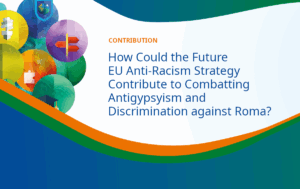EURoma’s proposals aim to contribute to increasing the effectiveness of the new Anti-Racism Strategy (2026-2030) in combating discrimination and anti-Gypsyism experienced by Roma across the EU.
In the context of the consultation process launched by the European Commission to gather the views of those in favor of the future Anti-Racism Strategy, the EURoma Network shares its proposals for the future EU Anti-Racism Strategy, with the aim of maintaining and strengthening the fight against racism and discrimination experienced by Roma throughout the European Union (EU). These proposals are based on discussions within the Network and the experience of partner countries.
The EURoma Network welcomes the development of a new EU Anti-Racism Strategy for the period 2026-2030. This Strategy will be crucial for building a more inclusive and equitable society that upholds the fundamental rights of all people, including Roma. Building on the experience of implementing the 2020-2025 Anti-Racism Action Plan, it should strengthen the protection of rights holders (in cases of institutional and interpersonal racism) and develop targeted, measured policies to combat structural racism and discrimination in key sectors such as employment, education, and housing.
Why maintain and strengthen the fight against racism and discrimination against Roma in the future EU Anti-Racism Strategy?
The introduction of the first EU Anti-Racism Action Plan (2020-2025) marked a significant step forward in bringing racial discrimination onto the political agenda and specifically recognizing Roma as one of the groups experiencing discrimination, hate speech (including online), hate crimes, and anti-Gypsyism. However, there is a feeling that, to date, the Action Plan has provided limited added value in addressing racism and discrimination against Roma.
Despite some overall progress, Roma continue to face widespread and persistent racism and discrimination, particularly in access to employment, education, healthcare, and housing (in some cases, the situation has even worsened). The 2023 Eurobarometer survey on discrimination in the EU shows that Roma suffer the most widespread discrimination of all groups considered. Reports by the EU Agency for Fundamental Rights (FRA) also reveal alarming data on discrimination against Roma in all areas. The European Commission’s Report on the Implementation of the EU Anti-Racism Action Plan 2020-2025 (2024) also provides relevant information on the progress made and remaining challenges in policies, practices, and initiatives, including those related to Roma.
Furthermore, there is room for improvement in cooperation between the coordinators of National Anti-Racism Action Plans (NAPARs) and National Roma Contact Points (NCCPs), as well as with the managing authorities of the European Social Fund Plus (ESF+)/European Regional Development Fund (ERDF). This affects the alignment between NAPARs and National Roma Strategic Frameworks (NSSFs), as well as between these and EU funds.
EURoma Network Proposals
EURoma presents five key proposals to ensure that the future Strategy effectively addresses the discrimination and anti-Gypsyism experienced by Roma:
- Inclusion of a specific chapter on anti-Roma discrimination and anti-Gypsyism
This specific chapter, to be included in both the EU Strategy and the country’s NAPARs/anti-racism measures, would ensure a more targeted approach and action.
– The chapter: Should include information and data illustrating the racism and discrimination experienced by Roma in different areas, including incidents of discrimination and hate crimes in different fields (e.g., employment, education, housing, social media, police, etc.), whether committed by individuals (interpersonal anti-Gypsyism) or at the institutional level (institutional anti-Gypsyism); and the more widespread forms of structural anti-Gypsyism that require greater attention, such as school segregation, segregated settlements, and substandard housing. Persistent stereotypes, prejudices, and ideologies that negatively portray Roma in these areas must also be considered.
– Based on this analysis, specific measures should be established to address the situation in the different areas and, in particular, the identified challenges. These measures should encompass policy, legislative, and institutional frameworks, as well as contribute to transforming prevailing narratives, combating stereotypes, and promoting a realistic, diverse, and up-to-date image of the Roma population, as well as fostering mutual understanding and coexistence. These measures should contribute to addressing incidents of discrimination and hate crimes, as well as forms of structural anti-Romaism.
– The specific situation of Roma women, who experience intersectional discrimination due to their Roma identity and their gender, must be taken into account. More generally, it is important to recognize that racial discrimination interacts with discrimination on other grounds, particularly with regard to the sexual/gender dimension of racism.
- Improved governance mechanisms to enhance coordination and cooperation
– The objectives of the future Anti-Racism Strategy should be aligned with existing frameworks (such as the EU Strategic Framework for Equality, Inclusion and Roma Participation and initiatives such as the EU Child Guarantee) and with future strategies and plans (such as the Affordable Housing Initiative and the EU Anti-Poverty Strategy). Integrating the fight against racism into EU policy frameworks and ensuring its effective implementation in national sectoral policies is essential to combating racism (including structural racism, as well as incidents of discrimination and hate crimes) experienced by Roma and other groups.
– Stronger and more effective governance mechanisms for coordination and cooperation between the bodies coordinating the NAPARs and those responsible for these sectoral policies are essential. The role of equality bodies and other relevant stakeholders in combating racism and discrimination against Roma should also be recognized.
– Regarding the EU Strategic Framework for Roma equality, inclusion, and participation, National Contact Programmes (NCPPs) and the bodies responsible for implementing the future Anti-Racism Strategy should establish regular, meaningful, and formal dialogue and coordination processes for the programming, implementation, and monitoring of actions. Coordination with ESF+ and ERDF authorities is also important to ensure the effective mobilization and alignment of EU funds to promote Roma equality and inclusion.
- Advancement of legislation explicitly addressing anti-Gypsyism
EURoma fully agrees with the Commission’s proposal to prioritize support for the implementation of the EU legal framework to combat discrimination, racism, xenophobia, hate speech, and hate crimes in the coming years.
Furthermore, it is necessary to further develop anti-racism legislation to include anti-Gypsyism and to introduce the latest human rights standards in the fight against different forms of discrimination, such as intersectional discrimination, online hate speech, and algorithmic bias. The most recent legislation on this subject is Directive 2000/43, so updating it seems necessary.
- Strengthening Victim Support Services
The future Strategy should give greater emphasis to providing robust support to victims of discrimination and racism, for example, through:
– Strong legal provisions ensuring sufficient powers to provide personalized assistance (including enhanced strategic litigation capacity) and adequate funding allocation (combining EU funding with national resources could contribute to achieving these objectives).
– Explicit recognition of the Roma population and implementation of targeted programming with specific measures, actions, and indicators.
This approach is in line with the provisions set out in recent EU Directives aimed at strengthening the role of national equality bodies in all Member States (EU 2024/1499 and EU 2024/1500).
- Strengthening support and monitoring at the EU level to ensure that anti-Gypsyism is effectively addressed in NAPARs.
The European Commission should increase its support and cooperation with Member States in their efforts to implement future NAPARs. Particular attention should be paid to:
– Improving capacity and monitoring the incorporation and implementation of Roma-related measures into national strategies, ensuring that anti-Gypsyism and discrimination against Roma are effectively addressed.
– Moving towards a harmonized approach to equality data collection across the EU. This could be achieved by developing a recommendation on equality data collection and establishing clear guidelines at the local, regional, and national levels to establish a data collection system with all the necessary safeguards, including disaggregated data.
– Furthermore, it would be relevant to collect, promote, share, and support the analysis of data on the prevalence of different stereotypes among Roma in the EU.
– Strengthening the role and powers of the EU Anti-Racism Coordinator to fulfill its duty to ensure the proper implementation of anti-racism policies by both the EU institutions and Member States. Facilitate mutual learning and the exchange of practices among Member States in the fight against racism and discrimination.
The EURoma Network will continue to play its role as a platform to engage partners in mutual learning and the sharing of positive experiences in combating discrimination against Roma and anti-Gypsyism, as well as how the use of EU funds can play a crucial role in this work.


